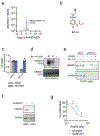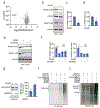Chemoproteomics-enabled discovery of a covalent molecular glue degrader targeting NF-κB
- PMID: 36898369
- PMCID: PMC10121878
- DOI: 10.1016/j.chembiol.2023.02.008
Chemoproteomics-enabled discovery of a covalent molecular glue degrader targeting NF-κB
Abstract
Targeted protein degradation has arisen as a powerful therapeutic modality for degrading disease targets. While proteolysis-targeting chimera (PROTAC) design is more modular, the discovery of molecular glue degraders has been more challenging. Here, we have coupled the phenotypic screening of a covalent ligand library with chemoproteomic approaches to rapidly discover a covalent molecular glue degrader and associated mechanisms. We have identified a cysteine-reactive covalent ligand EN450 that impairs leukemia cell viability in a NEDDylation and proteasome-dependent manner. Chemoproteomic profiling revealed covalent interaction of EN450 with an allosteric C111 in the E2 ubiquitin-conjugating enzyme UBE2D. Quantitative proteomic profiling revealed the degradation of the oncogenic transcription factor NFKB1 as a putative degradation target. Our study thus puts forth the discovery of a covalent molecular glue degrader that uniquely induced the proximity of an E2 with a transcription factor to induce its degradation in cancer cells.
Keywords: E2 ligase; NFKB1; UBE2D; activity-based protein profiling; molecular glue; targeted protein degradation; transcription factor.
Copyright © 2023 Elsevier Ltd. All rights reserved.
Conflict of interest statement
Declaration of interests J.A.T., J.M.K., and D.D. are employees of Novartis Institutes for BioMedical Research. This study was funded by the Novartis Institutes for BioMedical Research and the Novartis-Berkeley Translational Chemical Biology Institute. D.K.N. is a co-founder, shareholder, and on the scientific advisory boards for Frontier Medicines and Vicinitas Therapeutics; a member of the board of directors for Vicinitas Therapeutics; on the scientific advisory boards of The Mark Foundation for Cancer Research, Photys Therapeutics, Apertor Pharmaceuticals, Ecto Therapeutics, Oerth Bio, and Chordia Therapeutics; and on the investment advisory board of Droia Ventures.
Figures




Comment in
-
A new avenue for molecular glues: Rapid discovery of a NFKB1 degrader.Cell Chem Biol. 2023 Apr 20;30(4):340-342. doi: 10.1016/j.chembiol.2023.04.002. Cell Chem Biol. 2023. PMID: 37084716
References
Publication types
MeSH terms
Substances
Grants and funding
LinkOut - more resources
Full Text Sources
Molecular Biology Databases
Miscellaneous

